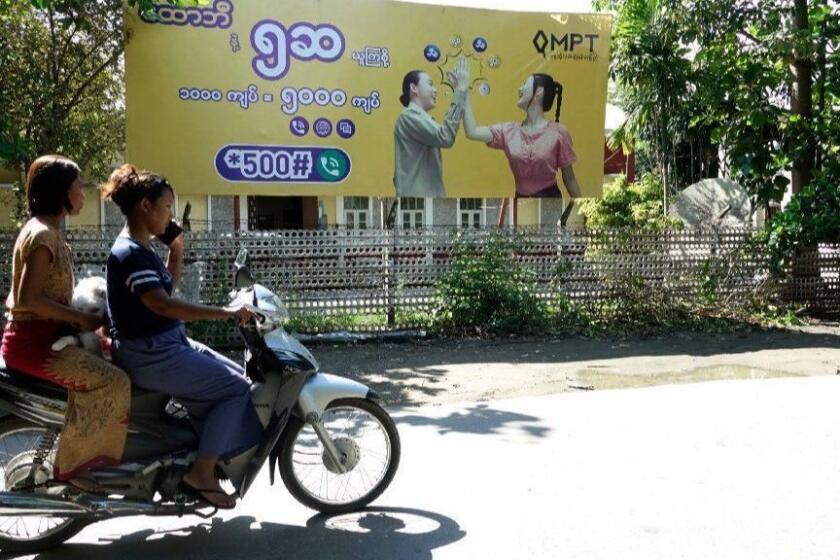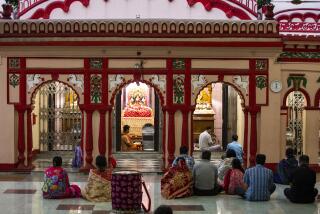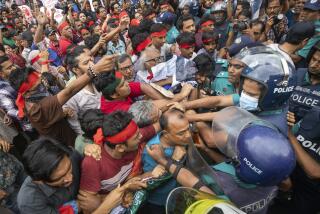For Muslims in India, ‘entire neighborhoods have gone empty in fear’
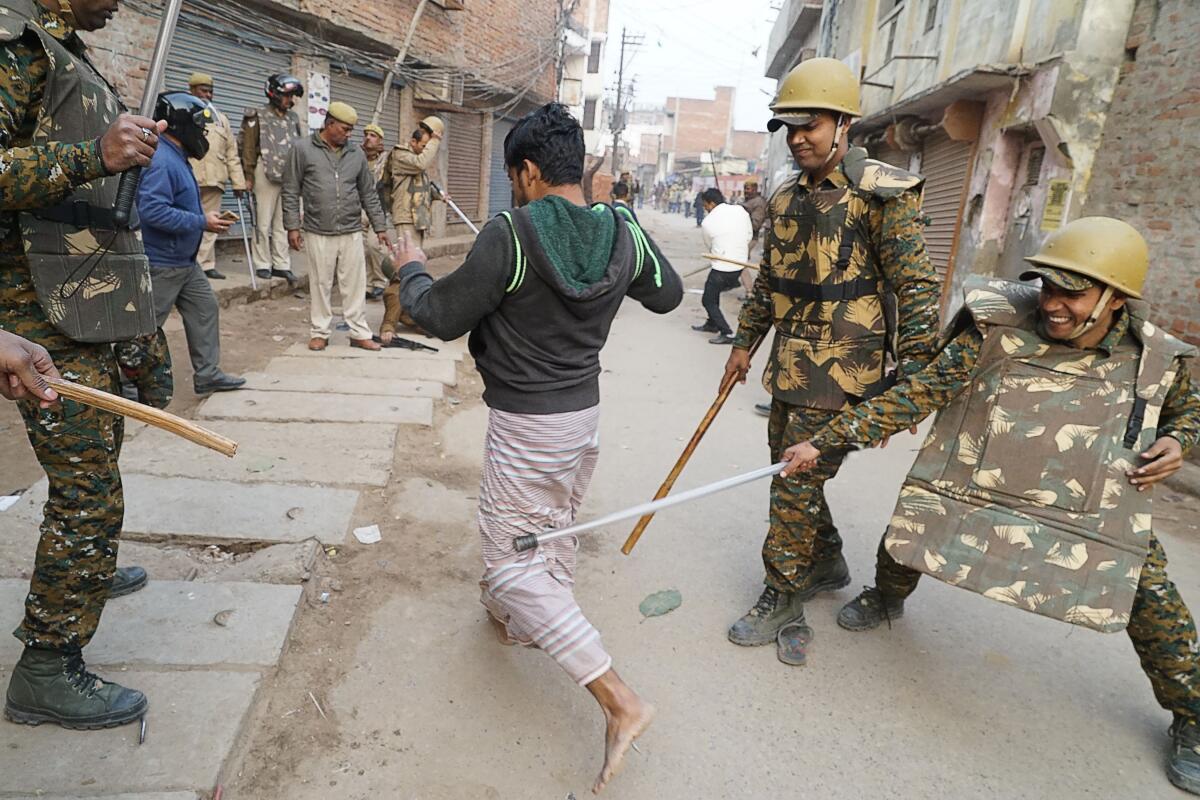
- Share via
NEW DELHI — When Indian police barged into the university library where Rohool Banka was studying, the 25-year-old student, a self-described proud Muslim, decided his best chance of survival was to pretend he was Hindu.
“In the name of God, let me go,” he told the police — but he intentionally used a word Hindus use for God, bhagwan, instead of the Muslim allah.
The ruse didn’t work. Banka and other Muslim students in the library said officers told them to recite the kalima — a statement of faith in Islam, often said before one dies — during a crackdown in which police fired tear gas, assaulted students with batons and left more than 100 injured.
The Dec. 15 incident at Jamia Millia Islamia, a New Delhi university with a Muslim-majority student body, has served as a major flashpoint in deadly unrest that has gripped large parts of India for almost two weeks.
Protests over a new citizenship law that critics say discriminates against Muslims have erupted across the country, with civilians and human rights groups accusing India’s police of using excessive force in predominantly Muslim areas and universities.

The allegations of religious bias have blighted Prime Minister Narendra Modi‘s record as leader of the world’s largest democracy. As demonstrations continued this week, Modi’s government enforced harsh laws against public gatherings and blocked internet access in some areas, making it more difficult for protesters to organize — and to report official abuses.
Many critics of Modi’s Hindu nationalist government say security forces have targeted Muslims, who make up approximately 14% of India’s 1.3 billion people, the largest religious minority in a country that is overwhelmingly Hindu.
Attempting to flee the campus, Banka said he was attacked by dozens of officers before police threw him like a “sack of potatoes” onto a pile of other students, many dazed or unconscious. Blood ran down the bridge of his fractured nose and his left eye was injured so badly that it eventually swelled shut.
“I was broken,” Banka recalled. “I was telling them, ‘I may die. Please leave me here.’ ”
Banka had entered the library that day to study for an interview for a post-graduate degree. Many students sought refuge there when clashes broke out between police and protesters at a nearby demonstration. The ensuing police crackdown meant that others, like Banka, who weren’t involved in the protest became victims of the violence as well.
“They broke everything and started beating us inhumanely. It was unexpected,” Banka said. “I have never seen people entering like this inside the campus — inside the library — and beating students.”
Banka remembered seeing another student, Mohammad Minhajuddin, lying on the floor of the library bathroom, bleeding from one eye. Minhajuddin eventually lost sight in that eye.
“I thought he was dead,” Banka said. “It was a helpless situation. I couldn’t help him because I was also bleeding.”
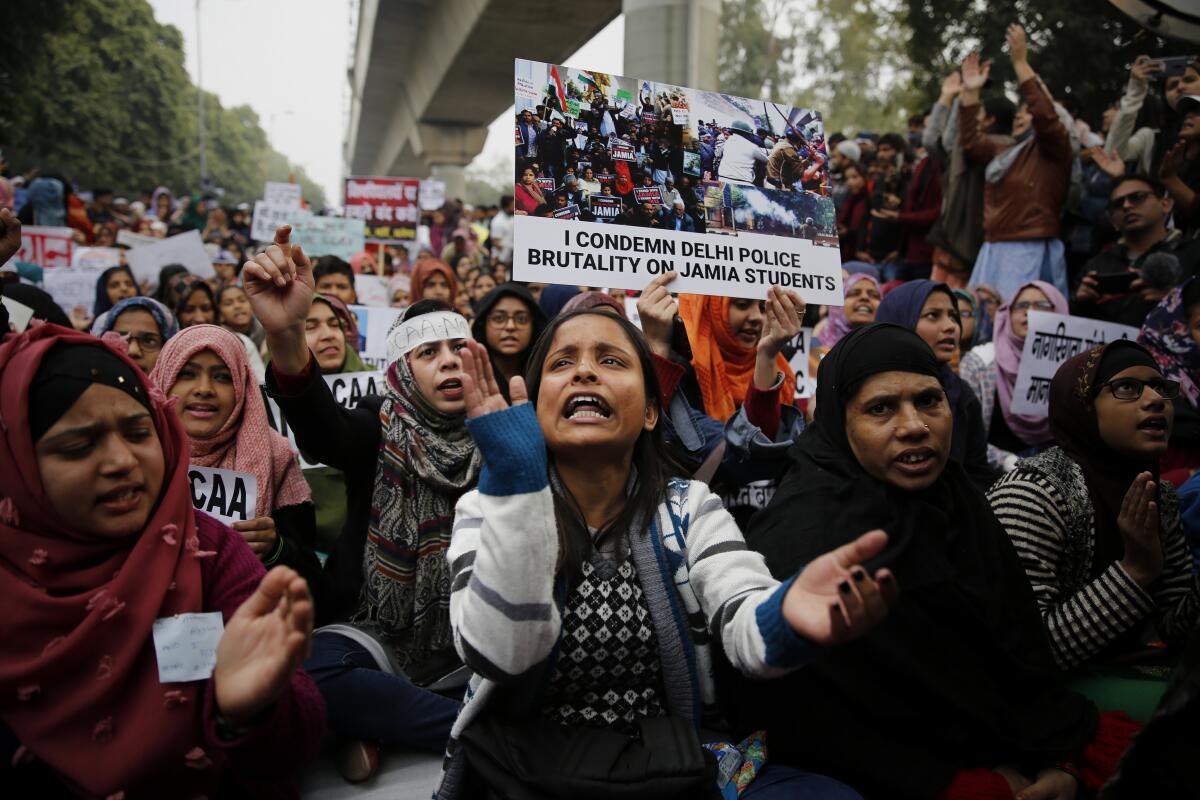
Hours later, when students at another predominantly Muslim institution, Aligarh Muslim University in northern India, marched in solidarity with Jamia Millia Islamia (National Islamic University), they too were met with force — by some accounts, even more ferociously than their peers in Delhi.
According to a fact-finding report led by prominent activist Harsh Mander and released this week, police and security forces fired stun grenades and bullets at Aligarh and used religious slurs against Muslim students.
The crackdown has been harshest in the country’s most populous state, Uttar Pradesh, where at least 17 people have been killed and more than 5,000 detained in the last two weeks.
With parts of the state under phone and internet blackouts, accounts of abuses have been difficult to confirm. But in news reports, residents have described a military-style crackdown on Muslim areas, with police opening fire on civilians, beating children, barging into homes and vandalizing property. Clashes between protesters and police have also taken place in Muslim areas of Delhi, and two Muslims were shot dead in the southern city of Mangalore on Dec. 19.
For civilians in Myanmar’s Rakhine state — who have survived army-led massacres, violence by ethnic militias, restrictions on humanitarian aid and the forced displacement of hundreds of thousands of neighbors — life just got more difficult.
Human Rights Watch has called on Indian authorities to cease using “excessive lethal force” against protesters. But according to witnesses and family members, many of those swept up in the crackdown were not protesting to begin with.
In the Muslim-majority town of Nehtaur, about 90 miles northeast of Delhi, 20-year-old Mohammed Suleman was shot dead by police last Friday after he went to a mosque to attend weekly prayers. Police say Suleman fired first, an allegation that his family vigorously disputes, saying he merely got caught up in a protest.
“Whatever the police are claiming, it is completely false,” said Munsab Malik, Suleman’s cousin. “It could never happen. They are doing it to save themselves.”
After receiving word that Suleman was lying on the ground covered in blood near the mosque, members of the family rushed over and took him to a hospital. But it was too late.
Their pain did not end there, however. Police prevented the family from taking the body home to perform last rites, saying the postmortem and burial needed to be conducted in another town.
Malik said the crackdown has had a chilling effect in Nehtaur. Protests have ceased and many residents have fled to ancestral villages, he said.
“Entire neighborhoods have gone empty in fear,” he said. “There’s so much pressure from the administration, like brute force. The way they treated the protesters shows their anger at us. The police are beating up protesters so viciously that some of them won’t be able to eat with their hands anymore.”

The spark for the protests was the Indian Parliament’s passage on Dec. 11 of the controversial Citizenship Amendment Act, which provides a path to Indian citizenship for refugees from three neighboring countries, unless they’re Muslim.
Many Indians worry the new law will be used in conjunction with a National Register of Citizens that could require all Indians to produce documents proving their origins, a challenge in a country where many people lack official proof of birth, land titles and other paperwork.
A citizens’ register this year in the northeastern state of Assam excluded 2 million people, many of them Muslim. Top government officials have pledged to introduce the program nationwide, although Modi in a speech this week appeared to back away from such a plan.

Critics of the government say its citizenship-related programs are purposefully confusing, designed to cover up a concerted effort to disempower Muslims. The moves are seen as the latest wave of a hard-line Hindu nationalist agenda pushed by Modi’s Bharatiya Janata Party, including a clampdown in Muslim-majority Kashmir and bans against slaughtering cows — an animal revered in Hinduism — that have emboldened attacks by Hindu vigilante groups.
The heavy-handed police response to protesters and bystanders has only intensified public outrage toward the state.
For Muslims in Uttar Pradesh, the violence is a realization of fears that arose in 2017, when Modi installed Yogi Adityanath , a firebrand Hindu priest, as leader of the state. Adityanath is known for his religiously inflammatory rhetoric, has been accused of inciting deadly riots and has spoken of turning India into a Hindu rashtra, or homeland.
It was a shocking story: A government hospital in the far north of India ran out of liquid oxygen because it hadn’t paid the supplier.
Adityanath said the government would take revenge against demonstrators and seize the assets of those who damaged public property. Uttar Pradesh police have denied using excessive force, while Modi this week defended security forces, saying that “people need to respect police, who are there to protect them.”
Some have likened the situation in Uttar Pradesh to religious riots in the state of Gujarat in 2002 that saw at least 1,000 people killed, the majority of them Muslim. Modi was leader of Gujarat then, and although he has never been charged with any wrongdoing in connection with the riots, many believe he could have done more to stop the violence.
“These were targeted attacks on Muslims,” said Karuna Nundy, a prominent lawyer. “Whether or not he had direct responsibility, the prime minister was chief minister of Gujarat at the time, and there has been no substantial justice, against either the rioters and those who were complicit.
“So I’m not surprised that little action has been taken against the ongoing violence in the state of Uttar Pradesh. The state is led by a chief minister who has been the prime accused in cases related to sectarian riots.”
Banka, whose family hails from Kashmir, said the violence casts doubt on whether Modi’s government is willing to protect India’s minorities.
“We used to give the example of this country being the largest democracy in the world,” he said. “But unfortunately ... most of the Muslims in this country are questioning this.”
Malhotra is a special correspondent. Special correspondent Prashun Mazumdar contributed to this report.
More to Read
Sign up for Essential California
The most important California stories and recommendations in your inbox every morning.
You may occasionally receive promotional content from the Los Angeles Times.
